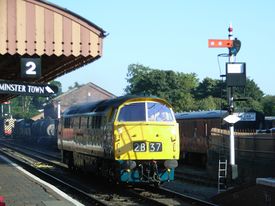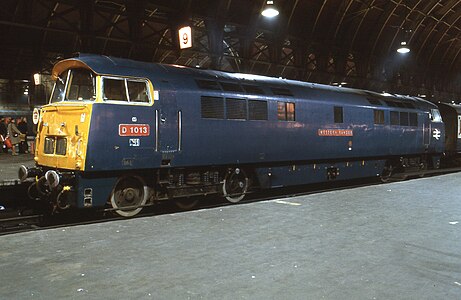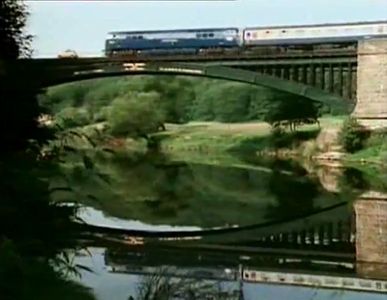BR Class 52 D1013 Western Ranger
| BR Class 52 D1013 Western Ranger | |
|---|---|
 D1013 Western Ranger at Bewdley in 2009 | |
| Built By | BR Swindon Works |
| Configuration | C-C |
| Power type | Diesel Hydraulic |
| Status | Under overhaul |
| Loco Number | D1013 |
| History | |
| Built | 1962 |
| Designed By | British Railways |
| Type | Class 52 |
| 1977 | Purchased by private owner |
| 1978 | Moved to SVR |
| 2009 | Overhaul began |
| Technical | |
| Length | 68ft |
| Weight | 108t |
D1013 Western Ranger is a BR Class 52 Type 4 diesel-hydraulic locomotive. A total of 74 were built for BR's Western Region between 1961 and 1964. All were given two-word names beginning "Western", hence the type became known as Westerns. Other nicknames included D1000s or 'thousands', and 'wizzers'.
Contents
BR Class 52 locomotives
During the 1950s the British Transport Commission (BTC) developed plans to phase out steam and introduce diesel and electric locomotives. Of the two main types of diesel traction, the BTC favoured diesel-electric ("DE") where a diesel engine is used to power a generator which in turn power electric traction motors, normally axle-mounted, their preference being mainly due to the lower revving diesel engines supposedly requiring less maintenance. However the individual BT regions enjoyed a high degree of autonomy in setting the design criteria for their locomotives and the Western Division continued the GWR tradition of being different by opting instead for diesel-hydraulic transmission ("DH"), commonly used at the time in Germany. This uses a torque converter (a similar principle to that found in an automatic car) to power the axles via cardan shafts and axledrives. Although this requires higher revving engine(s) to create the necessary torque, the system had several advantages:
- It resulted in a lighter locomotive than the equivalent diesel-electric transmission, providing a better power to weight ratio and reducing track wear.
- It gave a higher starting tractive effort, making it easier to move a heavy load from standstill.
- It had the capability to apply and maintain full power at low speed, useful on an incline (electric motors used extensively in that manner being prone to overheating)
- It had less potential for wheel slip due to the axles being coupled by the cardan shafts (with individually powered DE axles a single axle can slip, causing a temporary reduction in power as the locomotive 'finds its feet').
The Western Region initially introduced the Type 3 B-B Hymeks, Type 4 (Class 41) A1A-A1A and B-B Class 42/43 Warships into service, but these had proved underpowered for top-link services. In early 1959 the Swindon drawing office under BR(W) CM&EE Sam Smeddle began work on a new mixed traffic C-C design which would become the Western, essentially an enlarged 'Warship' with two more axles and more powerful charge air-cooled diesel engines. While design work was still in progress, the BTC ordered 74 of the Type of which 35 were to be built at Swindon and 39 at Crewe. In the event only D1000-29 were built at Swindon with the first of the class, D1000, entering service in December 1961.
From introduction the Westerns were used mainly on express passenger work, but also on heavy freight duties. They initially suffered from reliability issues, mainly with the transmission output shaft bearings and final drives. By the late 1960s these had been resolved and the locomotives performed well on the accelerated services introduced to compete with the M4 motorway. However the working life of the class would be relatively short. By 1968 the transfer of freight to roads and the removal of rural networks and branch lines meant BR had too many locomotives. The hydraulics were unpopular with BR engineering, mainly due to the additional maintenance costs, and the 1968 traction plan foresaw their end.
The arrival of class 50s and the air-conditioned Mark 2 stock which required ETH saw the Westerns increasingly used on freight duties. Swindon stopped overhauling Westerns in autumn 1972 and withdrawals began in 1973, with the last members of the Class including D1013 being withdrawn in early 1977. Seven examples are preserved of which four are resident on the SVR; D1013 Western Ranger, D1015 Western Champion, D1048 Western Lady and D1062 Western Courier.
D1013 in service
D1013 Western Ranger was outshopped from BR Swindon Works in December 1962. Its allocations were:
- Dec 1962- 88A Cardiff Canton
- Mar 1963- 81A Old Oak Common
- Apr 1963- 88A Cardiff Canton
- Feb 1965- 87E Landore
- Apr 1966- 84A Laira
- Apr 1968- 87E Landore
- Oct 1971- 84A Laira
While in service it carried the following liveries:
- 1962-1967: Maroon with half-yellow warning panels, black backed number and nameplates and black roof panels.
- 1967-1976: Blue with full yellow warning panels, black backed number and nameplates.
- 1976-1977: Blue with full yellow ends, red backed number and nameplates.
On 26 September 1965, D1013 was involved in an accident at Llanharran, South Wales, while hauling the 16.15 Swansea to Paddington express service The locomotive hit the tail end of a crane while travelling at around 35mph, sustaining damage to the front end.
As the Class numbers dwindled, their popularity rose giving rise to increasing numbers of enthusiast railtours from around 1975. D1013 became a 'railtour' engine, and its red backed number plates gave it notoriety as a 'fairground' engine. One such tour was the 'Severn Valley Flyer' on 1 May 1976 from Swansea to Kidderminster and return.[1]
On 26 February 1977, D1013 and D1023 Western Fusilier worked the last Western rail tour on BR, the "Western Tribute" Paddington – Swindon – Newport – Swansea – Newport – Bristol – Plymouth – Newbury - Paddington. Two days later the remaining members of the Class including Western Ranger were withdrawn from service, with D1013 having achieved around 1.3 million miles in service.
D1013 in preservation
On 14 May 1977 D1013 was purchased from BR by Holdsworth Conversions Ltd., a company owned by Mr Richard Holdsworth, a member of the Western Locomotive Association. He put the locomotive under the care of the WLA. On 14 June 1977 D1013 was hauled to the Paignton & Dartmouth Railway by Class 47 47013 where it joined D1062 Western Courier. On 9 October 1977 D1013 made its first official run in preservation during a "Western Day" on the Torbay Steam Railway with D1062.
The final working on the Torbay Steam Railway was on 29 April 1978. Both locomotives left the railway on 6 August 1978 and were hauled to Cardiff Canton depot for tyre turning. On 29 September 1978 they were hauled from Cardiff Canton to Foley Park on the SVR, becoming the SVR's first main line diesels. SVR News noted that their arrival would "obviously be the cause of much debate"; the original draft locomotive agreement envisaged that they would be based at Bridgnorth and operated on special "Western" weekends and certain other occasions, but not normally used instead of steam on scheduled SVR trains.[2]
On 31 March and 1 April 1979 D1013 and D1062 took part in the SVR's first "Western Weekend", the 1 April seeing the first double headed 'Western' hauled train in preservation.
In 1982, Western Ranger was used in the filming of the BBC TV sit-com L For Lester.
On 11 May 1984, D1013 was the first SVR locomotive to work onto the newly acquired Kidderminster site, hauling a load of sleepers for installation at the station which was still under construction at the time.[3]
On 9 March 1985 4930 Hagley Hall failed, with D1013 working the 16:20 from Bridgnorth to Kidderminster.[4] The same year 1985 Holdsworth Conversions Ltd. became insolvent and the receiver advertised the locomotive for sale. The WLA informed the receiver that major parts were owned by the Association, removal of which would render the locomotive out of gauge for removal. Sale was agreed and on 16 October 1995 ownership passed to Roger Smith, remaining under care of the WLA. On 22 March 2000 ownership passed to Western Ranger Limited, before being passed to the WLA.
On 15 September 1991, five of seven surviving Class 52s, including three now resident on the SVR, were reunited at the Plymouth Laira Depot opening day.[5]
In April 2001 D1013 was repainted at Kidderminster, the new livery being blue with full yellow warning panels, black backed number and nameplates. On 23 March 2002 it received an overhauled "A" end engine.
Overhaul from 2009
In 2008 the WLA received a Preservation of Industrial and Scientific Material (PRISM) Fund award of £2,500, which covered the first stage of restoration.[6] The main picture above shows D1013 in September 2009. On 10 October 2009 the locomtive was withdrawn for overhaul at Bridgnorth, with rewiring a particular priority. Work is progressing, with D1013 moving to the Diesel Depot on 25 November 2018 to facilitate the rest of the overhaul.[7]
In 2021 the WLA announced that experience gained on D1062 Western Courier meant that the overhaul would be extended to include a full bogie overhaul. They intended much of this would be outsourced to ensure that work complied with legacy British Rail specifications and other safety standards, and launched an appeal for private donations and sponsorship as a prelude to applying for £756,000 from The National Lottery Heritage Fund.[8] In May 2023, however, the WLA's expression of interest was rated as 'low priority' by the NLHF, and they instead devised a plan using existing resources to bring the bogies up to standard, fit for towing on the main line at 60 mph, at a cost of £30,000[9].
Main line movements
Sister locomotive D1015 Western Champion is the only one of the seven preserved Class 52s to be registered for main line operations. The Class 52's method of construction usually precludes locomotives being winched on and off road trailers, and so moves to and from the SVR by the other Class 52s are always rail hauled. D1013's TOPS code is 89413.
See also
References
- ↑ 'Severn Valley Flyer' on Six Bells Junction (Retrieved 18 October 2021)
- ↑ SVR News 48
- ↑ SVR News 77
- ↑ SVR News 76
- ↑ BR Open Days (Retrieved 20 November 2023)
- ↑ [1] PRISM Fund Annual Report 2008-2009
- ↑ WLA Facebook 24 November 2018
- ↑ WLA bogie appeal website (Retrieved 18 October 2021)
- ↑ Western Locomotive Association June 2023 e-Newsletter
- "Hydraulic Legends", Railways Illustrated "Bookazine"
- WLA D1013 page
Links
Western Locomotive Association website
British Rail Class 52 on Wikipedia
| ||||||||||||||||||||||||||||||||||||||||||||||||||||||||||||||||||||||||


